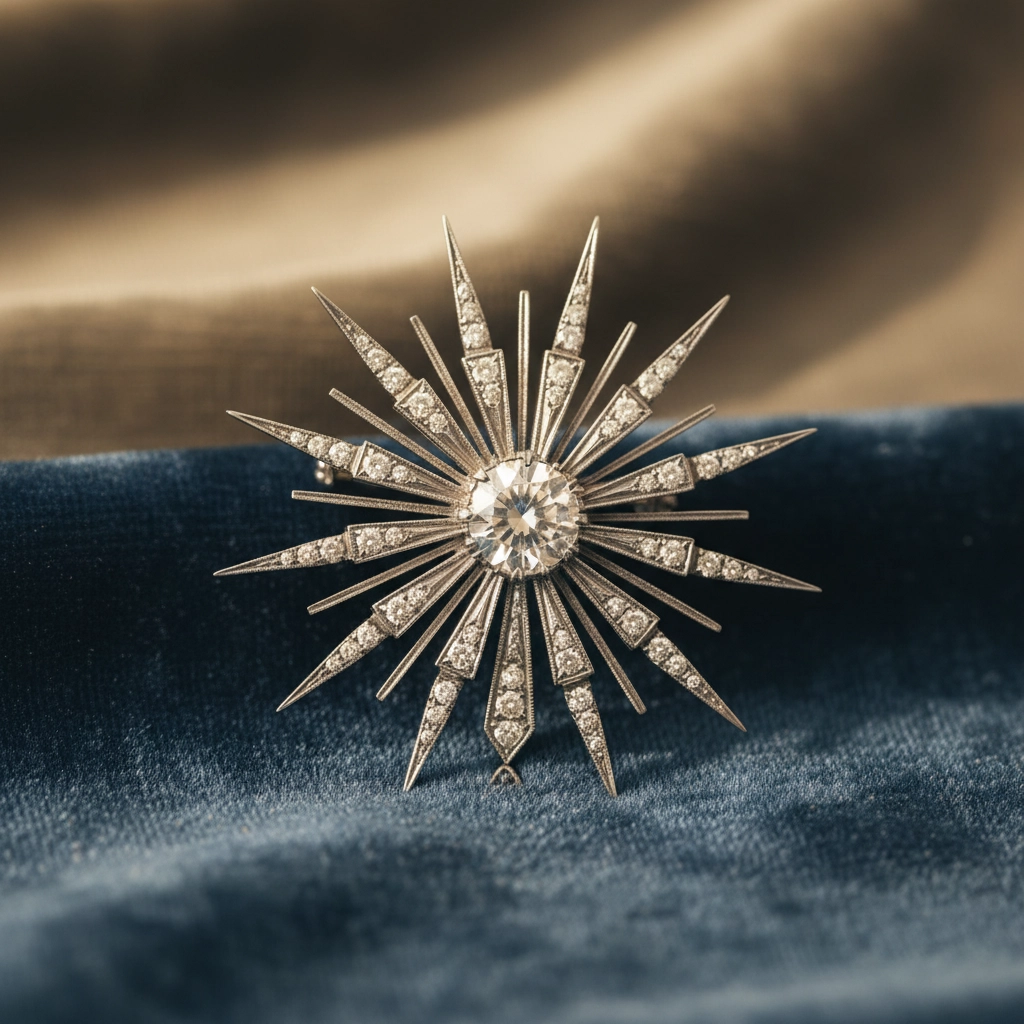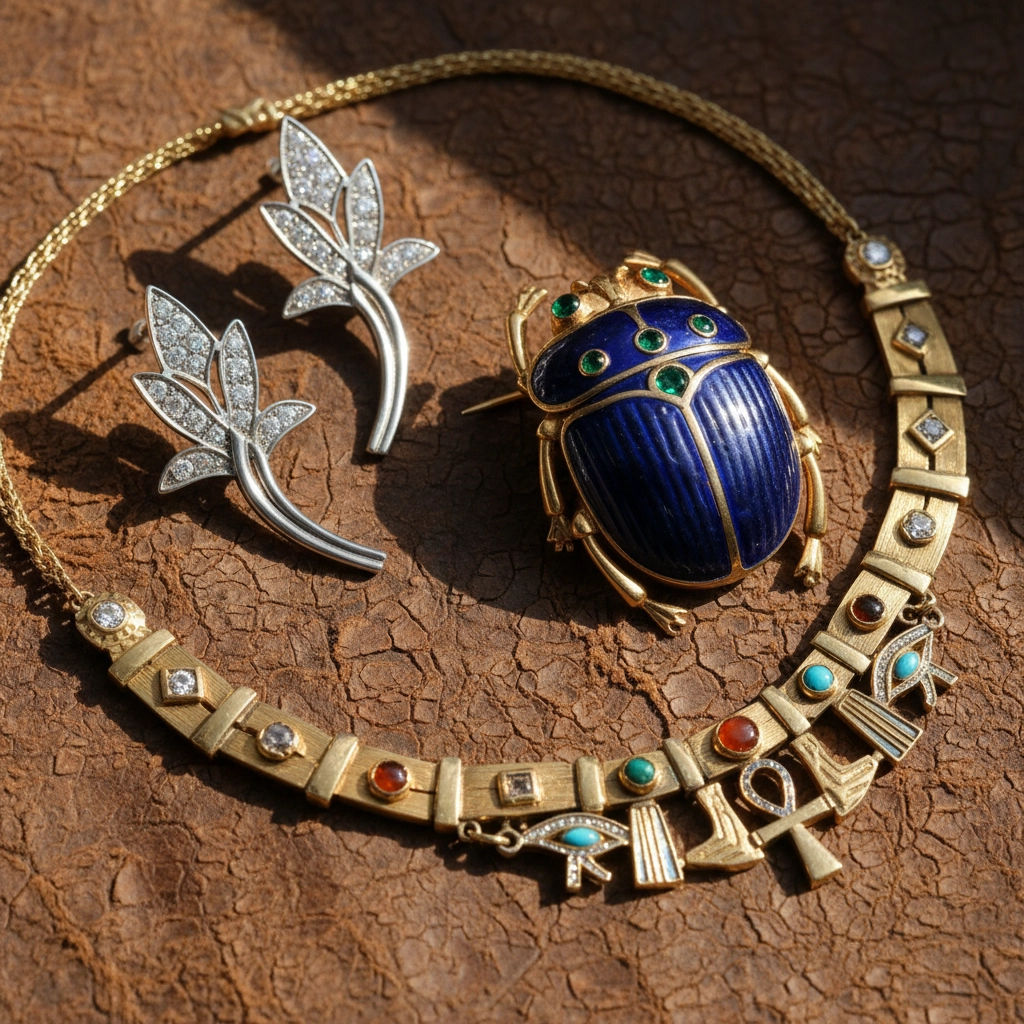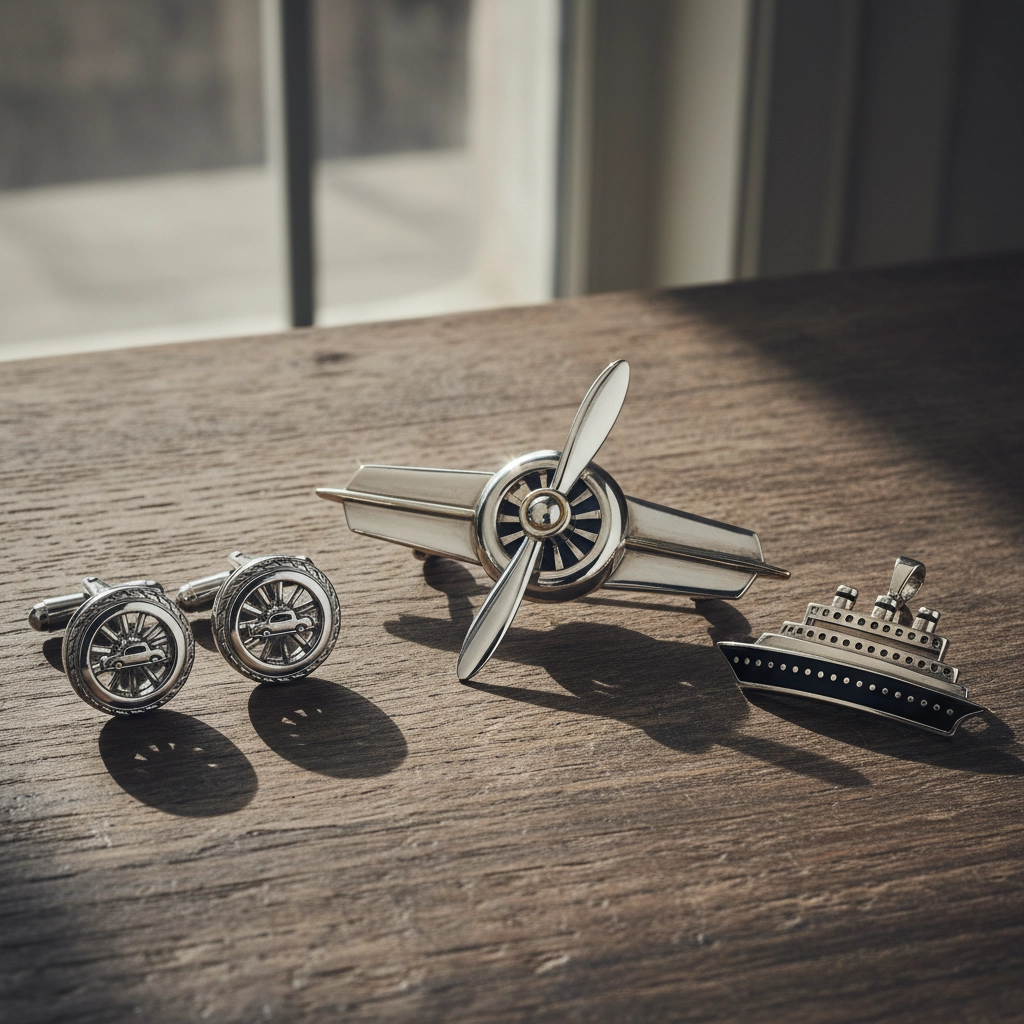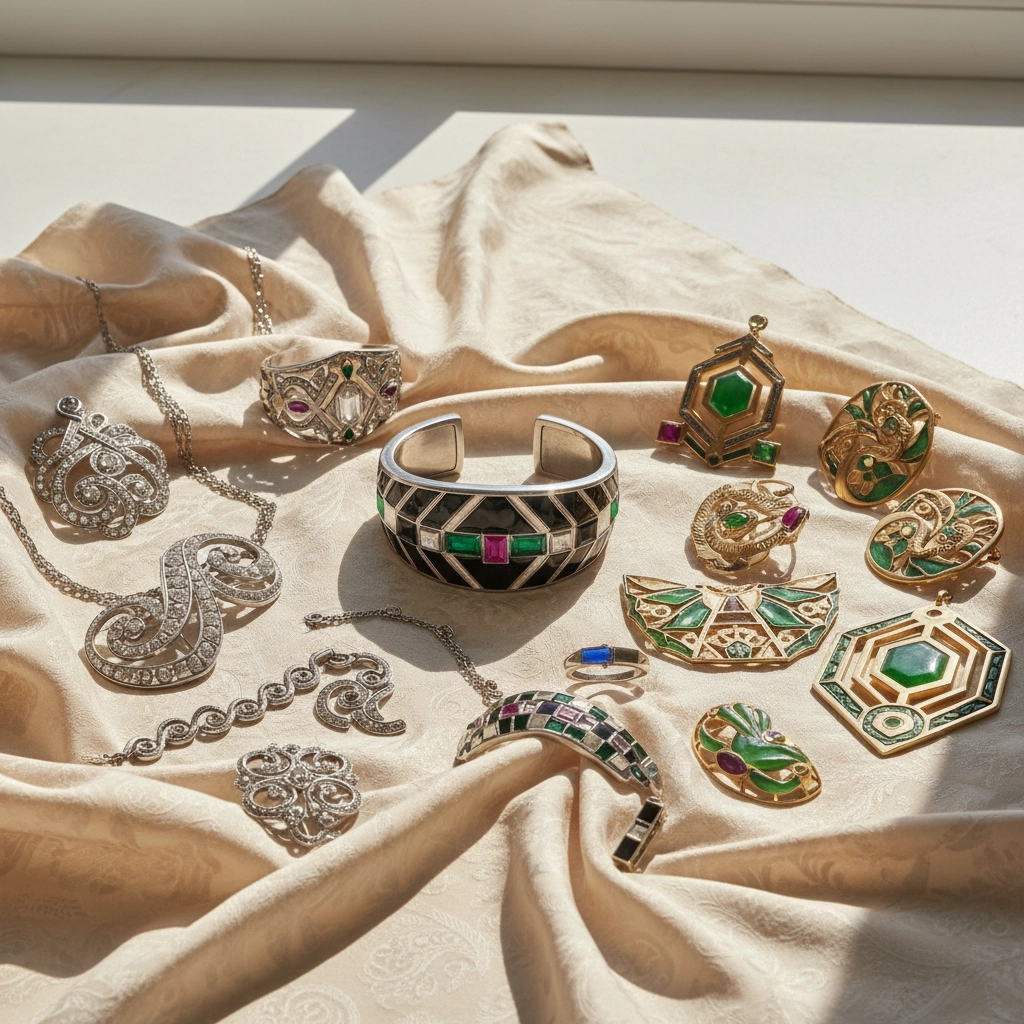Art Deco Era Jewelry, Part 2: Motifs, Meanings, and Signature Designs
Welcome back to our Art Deco journey! Yesterday we explored the cultural explosion that birthed this incredible era: now let's dive into the visual language that made Art Deco jewelry so instantly recognizable. Have you ever wondered why certain patterns just feel like the 1920s? Or why that vintage brooch in your grandmother's jewelry box screams "jazz age glamour"?
Today I'm breaking down the motifs, meanings, and signature designs that transformed jewelry from mere decoration into powerful symbols of a changing world.
The Geometry of Rebellion
When I examine Art Deco pieces, the first thing that strikes me is how deliberately geometric everything feels. This wasn't by accident: it was revolution. Designers were literally drawing lines in the sand, rejecting the flowing, nature-inspired curves of Art Nouveau for something bold, structured, and unapologetically modern.
Sunburst motifs became the crown jewel of this movement. Picture those radiating lines extending from a central stone: they weren't just pretty patterns, they symbolized the dawn of a new era. The sun was rising on modern life, and jewelry was there to celebrate it. I've seen countless brooches and hair ornaments featuring these radiating designs, each one like a tiny declaration of optimism.

Chevrons and zigzags took geometry to the dance floor. These sharp, angular patterns captured the energy of Charleston dancing and jazz rhythms. When you see that distinctive V-shaped pattern repeated across a bracelet or the jagged lightning bolt of a zigzag on an earring, you're looking at the visual representation of speed, movement, and the electric energy of the times.
Fan motifs offered another geometric favorite, often appearing in brooches and hair accessories. But these weren't just decorative: fans represented the exotic, the mysterious, and often nodded to Asian influences that were captivating Western audiences.
Cultural Fusion: When East Met West
One of the most fascinating aspects of Art Deco jewelry is how it became a melting pot of global influences. The 1920s saw unprecedented cultural exchange, and jewelry became a canvas for this international inspiration.
Egyptian Revival elements exploded in popularity, especially after the discovery of Tutankhamun's tomb in 1922. Suddenly, everyone wanted to wear a piece of ancient mystery. Scarab beetles, lotus flowers, and hieroglyphic-inspired patterns appeared on everything from rings to necklaces. These weren't just decorative choices: they represented eternity, rebirth, and the allure of ancient wisdom in a rapidly modernizing world.

Asian influences brought delicate pagoda shapes, stylized cherry blossoms, and geometric interpretations of traditional motifs. I find it incredible how designers took these ancient symbols and reimagined them through a modern, geometric lens. The result? Pieces that felt both timeless and cutting-edge.
Aztec and Mayan inspirations added bold, stepped patterns that perfectly complemented the geometric aesthetic. Those distinctive pyramid shapes and stepped designs weren't just exotic decoration: they represented power, mystery, and connection to ancient civilizations that seemed both primitive and sophisticated.
The Language of Materials and Color
Art Deco jewelry spoke through its material choices as much as its patterns. The era embraced bold color contrasts that would have shocked Victorian sensibilities. Black onyx paired with brilliant white diamonds, deep emeralds against platinum settings, vibrant coral with jet-black accents: these weren't subtle statements.
Platinum became the metal of choice for its modern, silvery gleam. Unlike the warm gold tones of previous eras, platinum felt industrial, sophisticated, and perfectly suited to the machine age aesthetic. When I handle authentic Art Deco platinum pieces, there's something about that cool, substantial weight that just feels right for the period.
The use of colored gemstones was revolutionary. Instead of relying solely on diamonds, designers embraced emeralds, sapphires, rubies, and even unconventional stones like jade, coral, and lapis lazuli. Each color choice carried meaning: emerald green for prosperity and new beginnings, deep blue sapphires for wisdom and royalty, vibrant red rubies for passion and power.
Symbolic Stories in Metal and Stone
Every Art Deco motif told a story about the times. Stylized flowers weren't the naturalistic blooms of Art Nouveau: they were geometric interpretations that celebrated nature while embracing modernity. A rose might be reduced to essential angular petals, a lily transformed into clean, geometric lines.
Transportation motifs reflected society's obsession with speed and movement. Stylized automobiles, ships, and airplanes appeared in jewelry designs, celebrating humanity's conquest of distance and time. I've seen incredible brooches shaped like streamlined trains and earrings inspired by airplane propellers: each piece a tiny monument to progress.

Abstract human and animal forms captured the essence rather than the reality. A gazelle might be reduced to flowing lines suggesting grace and speed, a woman's figure stylized into essential curves that spoke of liberation and movement. These weren't literal representations: they were emotional distillations.
The Architecture Connection
Art Deco jewelry and architecture spoke the same language. Those stepped, tiered designs you see in Art Deco buildings? They appeared constantly in jewelry: rings with stepped shoulders, brooches with graduated geometric patterns, earrings that echoed skyscraper silhouettes.
Skyline motifs became particularly popular as cities grew upward. Jewelry began reflecting this vertical ambition with stepped designs, graduated elements, and compositions that drew the eye upward: just like the magnificent buildings defining city horizons.
Regional Variations and Personal Expression
While Art Deco had recognizable characteristics, it wasn't uniform. European pieces often maintained more classical proportions and sophisticated color palettes, while American interpretations embraced bolder scales and more dramatic contrasts. Asian-influenced pieces incorporated traditional techniques with modern sensibilities.
What fascinates me most is how personal these pieces became despite their geometric precision. A woman might choose a sunburst brooch to signal her optimism, or select Egyptian-inspired earrings to express her fascination with ancient mysteries. The geometric language of Art Deco provided a vocabulary for personal expression within a shared cultural moment.

The Technical Revolution
The motifs and designs of Art Deco jewelry were made possible by advances in manufacturing and stone-cutting techniques. New diamond cuts: like the emerald cut, baguette, and various geometric shapes: perfectly complemented the angular aesthetic. Calibré cutting allowed gemstones to be cut to exact specifications, fitting perfectly into geometric settings.
Millegrain work added texture through tiny beaded borders, while filigree techniques created delicate, lace-like metal work that balanced the bold geometric elements. These technical innovations weren't just craftsmanship: they were artistic tools that enabled new forms of expression.
Living Symbols of Change
When I hold an Art Deco piece today, I'm not just admiring beautiful craftsmanship: I'm holding a tangible piece of one of history's most dynamic periods. Every zigzag pattern speaks of jazz rhythms, every sunburst motif celebrates the dawn of modernity, every geometric flower represents the balance between nature and machine.
These weren't just pretty objects: they were symbols of liberation, statements of independence, and declarations that the future was bright, bold, and beautifully geometric.
Tomorrow, in Part 3 of our series, we'll explore the revolutionary techniques and innovations that made these stunning designs possible: from new setting methods to groundbreaking manufacturing processes that brought Art Deco's geometric dreams to sparkling reality. Stay tuned!
Cheers,
Peter